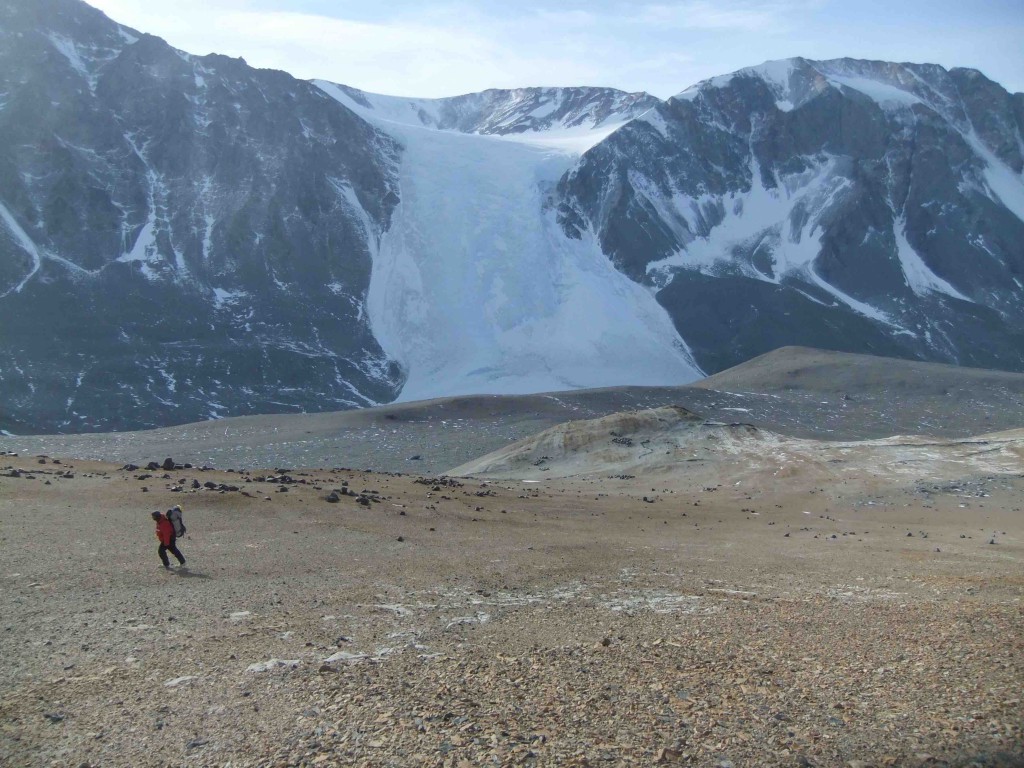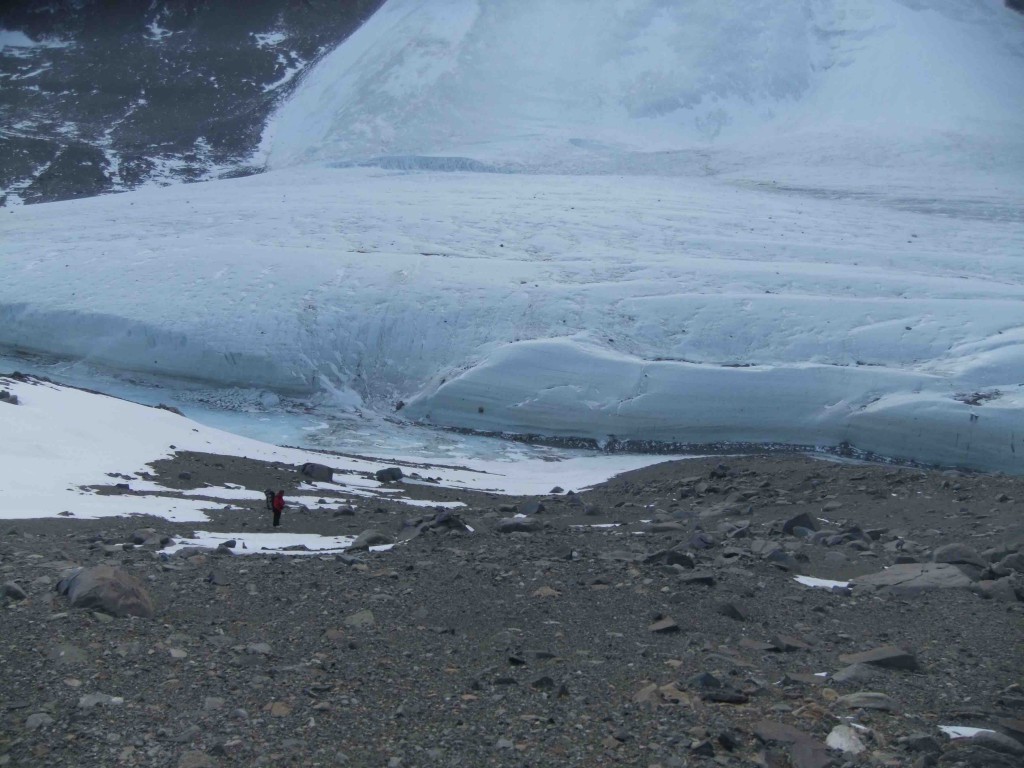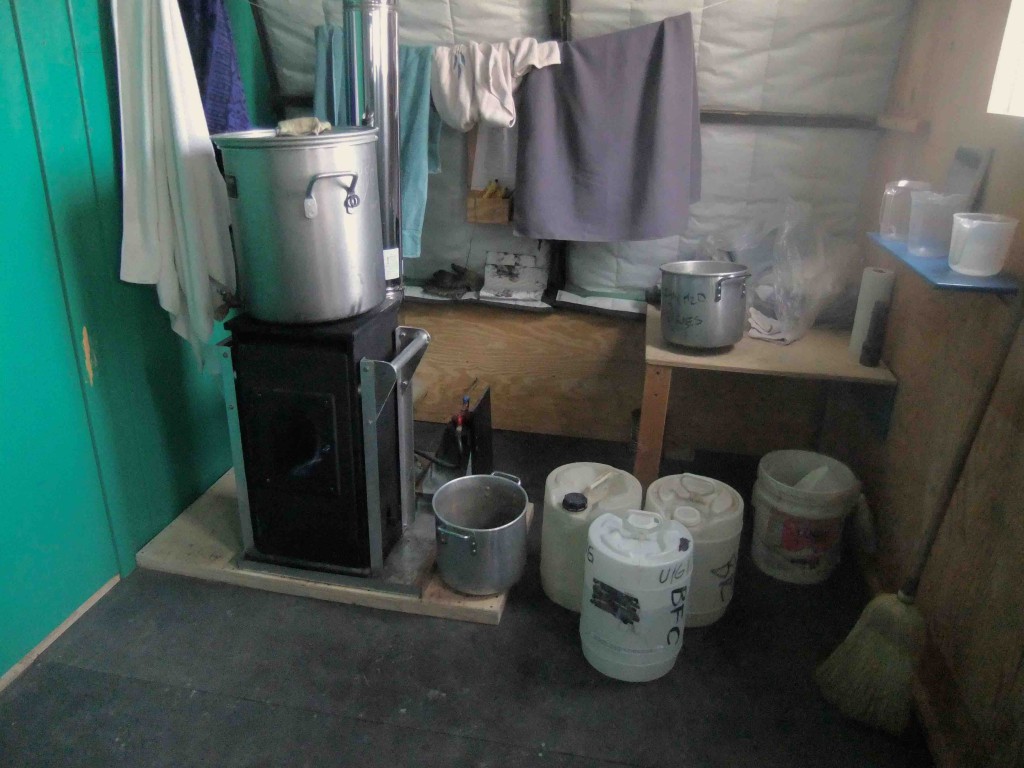Monthly Archives: November 2015
Jay and Kelsey Go to Lake Hoare
Our Rhone camp moved to Sollas camp on Friday, joining up with the remaining group members. It was so good to see them! Happy reunion.
After camp put-in and some recon on Saturday, Jay and I hiked on over to Lake Hoare. It’s a three hour hike from our Sollas campsite, across some awesome patterned ground. We saw ripples of basalt pebbles oriented with the katabatic wind direction, and tons of ventifacts. At the final approach to the lake, we passed right next to Suess Glacier and the boulders melting out of its margin.

Lake Hoare camp is nestled between the lake, Canada Glacier, and the mountainside on the center left.
Maciej, a member of the Long-term Ecological Research (LTER) team picked us up on an ATV once we reached the lake edge. Never been on an ATV before! We crossed over the frozen lake moat going a very satisfying speed of much-faster-than-walking.
Lake Hoare is a permanent establishment, managed by a wonderful woman, Rae, and her lovely assistant Reneé, who you’ve already met. It was very exciting indeed to see buildings and new people, including three other LTER folks. We sat at a table! I washed my hands! I bathroomed in an outhouse with walls!
Rae made us a really marvelous Indian dinner, with saag paneer and daal and a potato and veggie dish. It’s kind of surreal to eat that sort of thing in Antarctica. It was even more surreal to have kiwi the following morning. Kiwi! I don’t even eat that in Massachusetts!
After dinner, Krista and I washed dishes, and it was the best dishes washing experience I’ve ever had. Warm, soapy water has never felt so good. My hands even got enough of a soaking that most of the dirt came out of my fingerprints. Also, I showered. Sorry folks, I know I said it’d be 6 weeks sans showering, but Rae had a hot water pot with a bag to fill, which you can pulley up and use as a shower. It was quite enjoyable. And, I slept warm for the first night so far. Granted, this sleep was performed on the floor of the shower room where the hot water pot was warming up. It was still marvelous. A good place it is, that Lake Hoare.
Our Tent Blows Away
Well. Antarctica is a windy place. In our training, we were repeatedly warned, “The Dry Valleys are #@&#$@% windy.” All our stuff is rocked down. There are rocks on our food boxes, rocks on our urine containers, rocks on our propane tanks, rocks all over the outsides of our tents, rocks on our tent stakes, and, bizarrely, rocks on our rock samples. There are a lot of rocks. I did not imagine just how many rocks I would be using as weights.
Regardless, one of our tents blew away.
Extremely strong winds fell off of the ice sheet, accelerating downhill, and slammed into our camp on Thursday night. We had barely made it back in from hiking. The winds are sudden and strong, and called katabatics. This katabatic started out of nowhere. It was a gorgeous day, 12 degrees F or so, sunny, windless. And then the katabatic hit. The sides of the Scott tent were basically punching us in the face. I, having never been through a proper katabatic, thought the whole Scott tent was going to rip apart.
The Scott tent survived, but one of the mountain tents did not, despite the staking and the rocking. The fly acted as a sail, and up and out went the tent, off down the hill, through a gulley, and out to frozen Lake Bonney. Within a few minutes, the thing was several kilometers away. Very impressive. Fastest moving tent award.
Several shout outs:
From Kelsey: Happy birthday Mom!
From Rachel to family: I love you more.
From Rachel to Mom: I think I want to get a nose ring.
Looking for Lake Sediments
In the past, when thick ice from the Ross Sea blockaded Taylor Valley, glacial meltwater pooled into a large lake. This happened over and over again, as ice from the sea retreated and returned. When the lake was around, Taylor Glacier was probably smaller, although nobody really knows how small.
It’s strange to think that quite a sizable lake could grow in this very dry and frozen place. But we see lake deposits way up on the valley walls, stretching several hundred feet above the valley floor.
The lake sediments are fine, yellowish and silty, hidden beneath a thin veneer of granitic and basaltic cobbles. Kate, a new tech from the BFC named Sparky, and I hiked around today looking for lake sediments. We want to trace them far up the hillslope, mapping out their maximum height. And they’re high! Way, way above the modern Taylor Glacier.
It’s chilly work, though. It was a very cold day, cloudy with strong winds coming off the ice sheet. It’s extremely unpleasant to take notes and label sample bags in thin gloves when your body is already chilled. The hands stop working, and it takes much longer to do tasks, which means you’re out in the cold longer. There’s only so much hand warmers can do when your fingers are too cold to give off much heat.
Anywhoo, we were cold, but we did find lake sediments. Yellow silt buried under boulders, on the hillslopes, inside moraines, in gullies, everywhere. AND, we found a special surprise, as far as I’m concerned. Big old salt deposits! Powdery white, hardened halite (table salt) hanging out in clumps bigger than my fist. I love salt. And here, usually, salt deposits get larger as the landscape ages, which means we were probably on some pretty old terrain. I’d love to be able to calculate an age for the landscape.
So…how do we stay warm?
How do we stay warm? Sometimes, the answer feels like, “We don’t.” But really, we go through bursts of hot and freezing.
I’m hot when:
- I’m hiking up That Hill, or its only slightly less sinister and as yet unnamed twin on the opposite side of Rhone Glacier.
- I’m sitting in the corner of the Scott tent furthest from the door when the cook stove is on.
I’m comfortably warm when:
- I’ve warmed up from the cook stove and have snuggled into my sleeping bag with toe warmers, two hot water bottles, two pairs of pants, two pairs of socks, three shirts, a sleeping bag liner, a thin coat above the sleeping bag and over my legs, Big Red over my torso, clothes shoved into the sleeping bag (along with my phone, camera, and radio, to keep the batteries warm), a neck gaiter, my hat pulled down over my eyes, and the sleeping bag hood pulled tight, AND it’s within five hours of going to bed, when the heat has not yet dissipated.
- I’ve hit the perfect point during shoveling/chiseling/drilling when I’m producing plenty of body heat but not yet enough to make me sweaty.
I’m cold when:
- All other times.
It took about a week, but I’ve figured out which clothes I should wear when in order to stay most comfortable. I love the neck gaiter. I love hand warmers and toe warmers, when I can get them working. I LOVE the snow goggles, which keep my eyes warm. Warm eyes! Treat yo’self.






